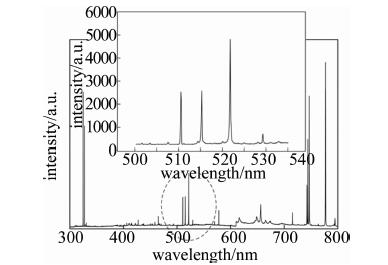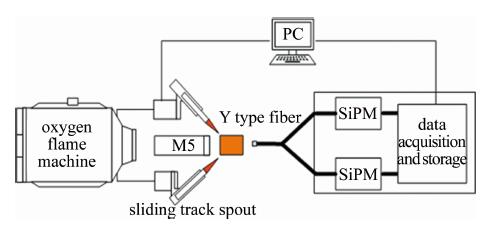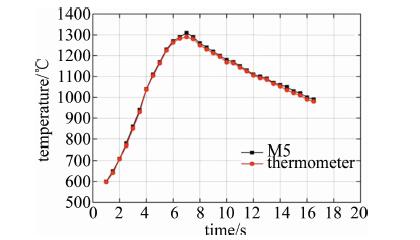HTML
-
温度是一个重要的物理量, 是工农业生产和航空、航天、核爆、化爆试验中测量的重要参量。因此,对于瞬态高温温度场的准确测量,对工农业以及国防军事的发展具有重要的意义,目前温度的测量方法主要分为接触式测温法和非接触式测温法[1]。在接触式测温中主要使用传感器与被测介质直接接触,进行热交换来获取温度,比较有代表性的是基于热电偶的高温测量技术[2-3],但热电偶会对温度场造成干扰, 高温环境也会缩短热电偶的使用寿命。为了弥补接触式测温方法的不足,国内外已经发展了多种非接触测温技术如比色测温法[4-5]、光谱测温法来实现瞬态高温的测试,原子发射光谱双谱线测温法采用了两条间隔比较小的光谱线[6-8],避免了比色测温法中忽略光谱发射率和透射率带来的误差[9]。更能适用于高温、高压等恶劣环境的温度测量。
在原子发射光谱双谱线测温公式中, 存在两个未知特定常数A, B,它们和测温系统的光学传递系数、所选原子的特性及谱线波长等因素有关。因此确定测温特定常数A, B的值,可以提高测温的精度,对原子发射双谱线测温法的广泛应用具有重要意义。
-
根据原子发射光谱相关理论,在热力学平衡或局部热力学平衡条件下[10-11],由玻尔兹曼分布及爱因斯坦辐射理论[12],可得同一种元素两条原子谱线的强度之比为:
式中,Iλ1和Iλ2为所选波长λ1和λ2光信号的谱线强度;A1和A2为原子谱线的跃迁几率;g1和g2分别为谱线激发态的统计权重;E1和E2为原子发射谱线的激发电位;K为玻尔兹曼常数[13];T为激发温度。考虑到测温系统的光学传递系数,将(Iλ1/Iλ2)乘上一个系数加以校正并对公式两边求对数得到:
式中,A1, A2, g1, g2, E1, E2均为与受激发原子及谱线波长λ有关的常数。故令:
从(3)式可以得到原子发射双谱线测温的基本公式为:
式中, A和B的值跟原子的特性、波长以及测温系统的光学传递系数有关, 可以利用标准温度对测温特定常数值进行确定。
-
光电测温器特定常数静态标定实验系统如图 1所示。本次实验中选用形状规则的紫铜片作为光谱激发样品。采用LS-3000高温黑体炉作为激发光谱的热源,该黑体炉最大可调节温度为3000℃。光电测温器由光学模块、光电转换模块和数据采集存储模块构成。光学模块由蓝宝石探头[14]、Y型光纤以及滤光片组成。蓝宝石探头是用来对光纤的端面进行保护,减少光污染,提高了光纤的传光效率,Y型光纤将蓝宝石探头采集的光谱信号均分两路,滤光片过滤得到所选特定波长的温标谱线。
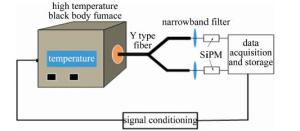
Figure 1. Schematic diagram of static calibration experiment of photoelectric temperature measurement system
光电转换模块使用爱尔兰Sensel公司的10035-X08型硅光电倍增管(silicon photomultiplier,SiPM)。该光电倍增管是具有单光子创新型固态硅探测器,具有高增益、响应速度快、工作电压低和集成度高等特点。具体参量如表 1所示。
parameter value spectral range (400~1000)nm photon detection efficiency at λp 20% peak wavelength λp 500nm gain 2.3×106 dark current 0.4μA recommended operating temperature rang (0~30)℃ breakdown voltage (27±0.5)V Table 1. 10035-X08 silicon photomultiplier tube parameters
数据采集存储模块采用ADI公司生产的AD9226高速模数转换器,可采集双路电压信号,最高采样频率达65MHz。采集的数据通过FPGA EP4CE6F17C8(256M DDR2-DRAM)芯片进行存储。
-
在利用原子发射光谱双谱线原理测温时所选的光谱线要清晰、强度适宜、无自吸现象[15-16], 谱线之间的激发能要特别大,而且两条谱线波长要接近,这样可以减小光谱辐射率和光谱透射率等对光谱测量的影响。
利用激光诱导击穿光谱技术对紫铜片进行光谱激发实验[17]。在300nm~800nm波长范围内Cu原子谱线分布图如图 2所示。本次实验中选用Cu Ⅰ 510.5nm和Cu Ⅰ 521.8nm作为测温时的温标谱线,在30mJ激光能量条件下,电子温度Te=0.5eV, 电子密度Ne=1×1010cm-3[18-19]。温标谱线光谱图如图 2标记放大部分所示。光谱线参量如表 2所示。
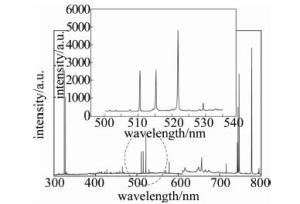
Figure 2. Atomic spectral distribution of Cu atoms at 300nm~800nm and CuⅠ 510.5nm and CuⅠ 521.8nm spectra
wavelength/nm transition level upper energy/cm-1 statistical weight transition probability/s-1 uncertainty/% 510.5 3d4p-4s 30784 4 0.02×108 25 521.8 4d-4p 40942 6 0.75×108 25 Table 2. CuⅠ 510.5nm and CuⅠ 521.8nm parameter values
-
高温黑体炉利用高温黑体辐射使Cu样品热激发产生光谱[20], 光谱经Y型光纤输出后经滤光片进入硅光电倍增管转换为双通道电压信号,电压信号经数据采集存储模块完成处理,最后在PC机上读出电压值。由硅光电倍增管转换得到的电压的比值为Cu Ⅰ 510.5nm和Cu Ⅰ 521.8nm的光谱强度的比值,因此有:
实验过程中高温黑体炉显示炉内标准温度,在700℃~2500℃温度范围内, 选取多个温度并进行多次测量所测得的双通道最大电压之比如图 3所示。

Figure 3. Results of the ratio of the maximum voltage of the two channels in the range of 700℃~2500℃
选择黑体炉炉内两个温度值分别为Tl, Tl′,并记录此时双通道数据采集存储模块最大电压之比分别为I1, 2, I1, 2′。由(4)式、(5)式可得A, B的计算公式:
实验结果如表 3所示。由实验结果可得, 在不同标准温度差的条件下测得A的最大误差值为0.0029,可得A=0.1083;B的最大误差值为0.993,可得B=628.387。
Tl/℃ Tl′/℃ I1, 2 I1, 2′ A B 700 1200 2.73 1.88 0.1074 628.158 800 1400 2.44 1.75 0.1076 629.007 900 1600 2.24 1.65 0.1081 628.212 1100 1700 1.97 1.61 0.1073 628.143 1300 1800 1.81 1.58 0.1102 629.147 1500 2100 1.70 1.51 0.1083 629.136 1900 2300 1.55 1.47 0.1091 628.153 2000 2500 1.53 1.43 0.1084 628.139 Table 3. Specific constants, static calibration results
2.1. 实验系统介绍
2.2. 测温原子谱线选择
2.3. 实验及结果分析
-
铜燃烧温度场测试实验如图 4所示。利用氢氧焰机可控双管路喷射火焰作为热源。以美国IRCON公司的Modline5型智能一体化红外红外测温仪(简称M5)作为标准测温仪器,其测温范围为600℃~1400℃。光电测温器采用特定常数标定后的原子发射双谱线测温器。铜具有优良的导热性,因此实验中采用紫铜片作为被加热对象,将紫铜片加工成30mm×30mm×1mm的薄片,可以保证紫铜片受热均匀。
实验中利用双管路氢氧焰喷射技术构建了温度范围、流体属性相对稳定的Cu燃烧温度场,通过喷射高温火焰对紫铜片进行烧灼,形成一个满足实验需求尺寸的高温区域,通过在喷出的燃气中搀杂一定的元素与物质,实现实际燃烧场多物理特性的模拟。结合多物理场控制原理引入反馈,实现根据人工设定的多物理场参量对2组喷嘴状态进行自动控制,从而实现Cu高温燃烧场环境的自动调控。
-
首先将紫铜片固定于特定的位置,放置于氢氧焰机双管路喷射火焰处行加热,然后利用光电测温器测量被加热铜片的温度,测温过程中待光电测温器温度显示在接近600℃的同时,M5红外测温仪对准铜片进行温度的测量。
实验过程中,铜片被氢氧焰加热而升温,并逐渐呈现亮红色,继续加热铜片燃烧并发出浅绿色火焰,最后生成黑色粉末状固体。光电测温器测得最高温度为1297℃,M5红外测温仪测得的最高温度为1315℃。测试结果如图 5所示。
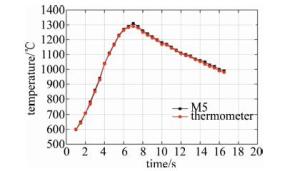
Figure 5. Temperature measurement results of photoelectric temperature measurement system and M5 infrared camera
设标准M5红外测温仪测得的温度为标准温度Tb, 设光电测温器测得的温度为测量温度Tc。实验结果如表 4所示。
Tb/℃ Tc/℃ relative error/% 600 592 1.3 665 657 1.2 715 707 1.1 786 776 1.3 883 871 1.4 937 925 1.3 1039 1027 1.2 1315 1297 1.4 1287 1271 1.2 1220 1203 1.4 1154 1139 1.3 1068 1054 1.3 1018 1004 1.4 974 961 1.3 Table 4. Temperatures measured by photoelectric thermometers and M-type infrared thermometers and their relative errors
由实验结果可得, 光电测温器测得的温度与M5型红外测温仪测得的温度平均相对误差为1.3%。
3.1. Cu高温燃烧温度场构建
3.2. 实验及结果分析
-
针对原子发射双谱线瞬态高温测温的问题。对原子发射双谱线测温系统进行了静态标定实验。得出特定常数A, B的值,并对标定后的测温系统进行铜燃烧温度场验证实验。实验结果表明:测温特定常数A, B静态标定实验对于原子发射双谱线测温法准确测量瞬态高温具有重要的意义。

 Map
Map


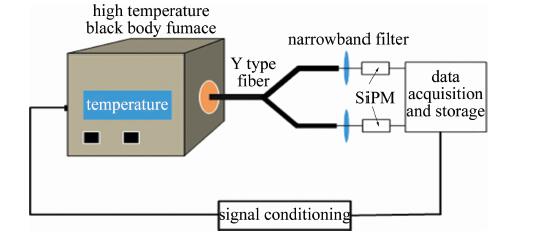


 DownLoad:
DownLoad:
